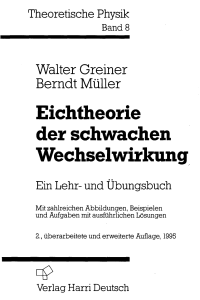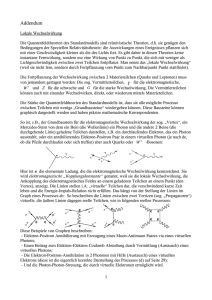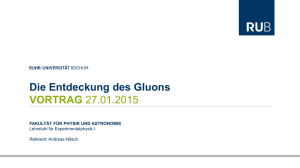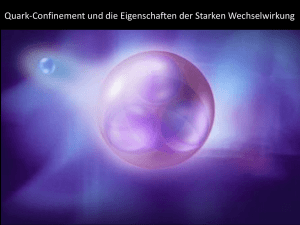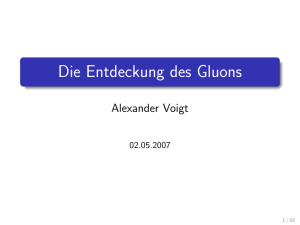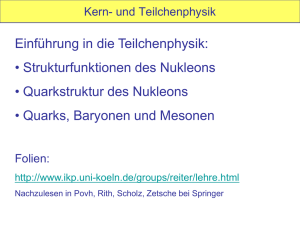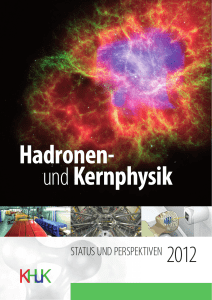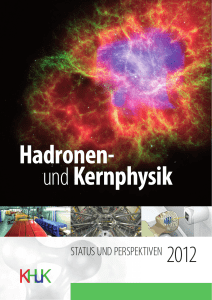11 - nadirpoint.de
Werbung
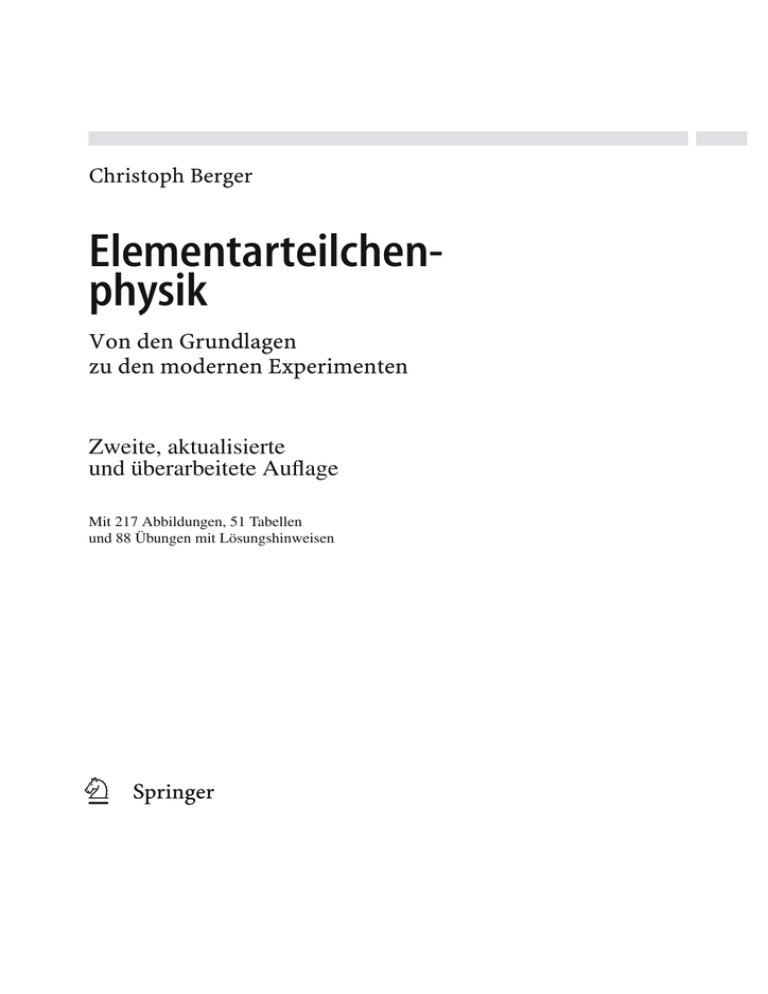
Christoph Berger Elementarteilchenphysik Von den Grundlagen zu den modernen Experimenten Zweite, aktualisierte und überarbeitete Auflage Mit 217 Abbildungen, 51 Tabellen und 88 Übungen mit Lösungshinweisen 1 3 Inhaltsverzeichnis Inhaltsverzeichnis 1 Überblick und Hilfsmittel 1.1 1.2 1.3 1.4 1.5 2 Strukturen der Materie . . . . . . . . . . . . . . . . . . . . . . . . . . . . . . . . . . . 1.1.1 Teilchen und Kräfte . . . . . . . . . . . . . . . . . . . . . . . . . . . . . . . . . 1.1.2 Abstandsskalen und Energieskalen . . . . . . . . . . . . . . . . . . . . 1.1.3 Intermezzo: Schreibweise und Maßsysteme . . . . . . . . . . . . . Die Elementarteilchen . . . . . . . . . . . . . . . . . . . . . . . . . . . . . . . . . . . . 1.2.1 Antimaterie . . . . . . . . . . . . . . . . . . . . . . . . . . . . . . . . . . . . . . . 1.2.2 Leptonen . . . . . . . . . . . . . . . . . . . . . . . . . . . . . . . . . . . . . . . . . 1.2.3 Hadronen . . . . . . . . . . . . . . . . . . . . . . . . . . . . . . . . . . . . . . . . . 1.2.4 Quarks . . . . . . . . . . . . . . . . . . . . . . . . . . . . . . . . . . . . . . . . . . . 1.2.5 Felder und Wechselwirkungen . . . . . . . . . . . . . . . . . . . . . . . . 1.2.6 Was ist ein Elementarteilchen? . . . . . . . . . . . . . . . . . . . . . . . Wirkungsquerschnitte und Zerfallsraten . . . . . . . . . . . . . . . . . . . . 1.3.1 Der Wirkungsquerschnitt . . . . . . . . . . . . . . . . . . . . . . . . . . . . 1.3.2 Zerfallsraten . . . . . . . . . . . . . . . . . . . . . . . . . . . . . . . . . . . . . . . Teilchenbeschleuniger . . . . . . . . . . . . . . . . . . . . . . . . . . . . . . . . . . . . 1.4.1 Linearbeschleuniger . . . . . . . . . . . . . . . . . . . . . . . . . . . . . . . . 1.4.2 Das Zyklotron . . . . . . . . . . . . . . . . . . . . . . . . . . . . . . . . . . . . . 1.4.3 Das Synchrotron . . . . . . . . . . . . . . . . . . . . . . . . . . . . . . . . . . . a) Prinzip . . . . . . . . . . . . . . . . . . . . . . . . . . . . . . . . . . . . . . . . b) Fokussierung . . . . . . . . . . . . . . . . . . . . . . . . . . . . . . . . . . . c) Magnete . . . . . . . . . . . . . . . . . . . . . . . . . . . . . . . . . . . . . . . 1.4.4 Speicherringe . . . . . . . . . . . . . . . . . . . . . . . . . . . . . . . . . . . . . . Detektoren . . . . . . . . . . . . . . . . . . . . . . . . . . . . . . . . . . . . . . . . . . . . . . 1.5.1 Detektoren an collidern . . . . . . . . . . . . . . . . . . . . . . . . . . . . . 1.5.2 Spurenkammern . . . . . . . . . . . . . . . . . . . . . . . . . . . . . . . . . . . . a) Detektoren mit Gasverstärkung . . . . . . . . . . . . . . . . . . . . b) Festkörperzähler . . . . . . . . . . . . . . . . . . . . . . . . . . . . . . . . 1.5.3 Kalorimeter . . . . . . . . . . . . . . . . . . . . . . . . . . . . . . . . . . . . . . . a) Elektromagnetische Kalorimeter. . . . . . . . . . . . . . . . . . . . b) Hadronische Kalorimeter. . . . . . . . . . . . . . . . . . . . . . . . . . 1.5.4 Blasenkammer . . . . . . . . . . . . . . . . . . . . . . . . . . . . . . . . . . . . . 3 3 6 14 17 18 20 26 32 37 42 43 43 46 48 48 51 52 52 55 61 62 64 64 69 69 71 72 72 74 74 Die Streumatrix und ihre Symmetrien 2.1 2.2 Die Streumatrix . . . . . . . . . . . . . . . . . . . . . . . . . . . . . . . . . . . . . . . . . . 79 2.1.1 Wirkungsquerschnitte und Streuamplitude . . . . . . . . . . . . . . 80 2.1.2 Zerfallsraten . . . . . . . . . . . . . . . . . . . . . . . . . . . . . . . . . . . . . . . 85 2.1.3 Symmetrien der S-Matrix . . . . . . . . . . . . . . . . . . . . . . . . . . . . 87 2.1.4 Das optische Theorem . . . . . . . . . . . . . . . . . . . . . . . . . . . . . . 90 2.1.5 Anhang über die δ-Funktion . . . . . . . . . . . . . . . . . . . . . . . . . . 91 Drehungen in drei Dimensionen . . . . . . . . . . . . . . . . . . . . . . . . . . . . 92 2.2.1 Drehungen . . . . . . . . . . . . . . . . . . . . . . . . . . . . . . . . . . . . . . . . 92 2.2.2 Die Drehgruppe . . . . . . . . . . . . . . . . . . . . . . . . . . . . . . . . . . . . 94 2.2.3 Darstellungen der Drehgruppe . . . . . . . . . . . . . . . . . . . . . . . . 96 2.2.4 Drehgruppe und halbzahlige Spins . . . . . . . . . . . . . . . . . . . . 100 2.2.5 Produkte von Darstellungen . . . . . . . . . . . . . . . . . . . . . . . . . . 102 IX X Inhaltsverzeichnis 2.3 2.4 2.5 2.6 2.7 2.8 3 Drehungen und Verschiebungen in vier Dimensionen . . . . . . . . . 2.3.1 Lorentz-Transformationen . . . . . . . . . . . . . . . . . . . . . . . . . . . 2.3.2 Die Poincaré-Gruppe . . . . . . . . . . . . . . . . . . . . . . . . . . . . . . . 2.3.3 Darstellungen der Poincaré-Gruppe . . . . . . . . . . . . . . . . . . . Anwendungen . . . . . . . . . . . . . . . . . . . . . . . . . . . . . . . . . . . . . . . . . . . 2.4.1 Kinematik der Zwei-Körper-Reaktionen . . . . . . . . . . . . . . . . 2.4.2 Zwei-Körper-Zerfälle . . . . . . . . . . . . . . . . . . . . . . . . . . . . . . . 2.4.3 Partialwellenentwicklung der Streuamplitude . . . . . . . . . . . 2.4.4 Resonanzen in Formationsexperimenten . . . . . . . . . . . . . . . . 2.4.5 Pion-Resonanzen . . . . . . . . . . . . . . . . . . . . . . . . . . . . . . . . . . . 2.4.6 Der Spin des Photons . . . . . . . . . . . . . . . . . . . . . . . . . . . . . . . 2.4.7 Der Spin des neutralen Pions . . . . . . . . . . . . . . . . . . . . . . . . . Spiegelungen und Paritätsinvarianz . . . . . . . . . . . . . . . . . . . . . . . . 2.5.1 Die Paritätstransformation . . . . . . . . . . . . . . . . . . . . . . . . . . . 2.5.2 Die Parität des Photons, des ρ-Mesons und der Pionen . . . . 2.5.3 Spin und Parität des K -Mesons . . . . . . . . . . . . . . . . . . . . . . . 2.5.4 Paritätsverletzung in der schwachen Wechselwirkung . . . . . Die Zeitumkehr . . . . . . . . . . . . . . . . . . . . . . . . . . . . . . . . . . . . . . . . . . 2.6.1 Zeitumkehr und das Prinzip des detaillierten Gleichgewichts 2.6.2 Invarianz der Wechselwirkungen unter Zeitspiegelungen . . Innere Symmetrien I . . . . . . . . . . . . . . . . . . . . . . . . . . . . . . . . . . . . . . 2.7.1 Globale Phasentransformationen . . . . . . . . . . . . . . . . . . . . . . 2.7.2 Die Teilchen-Antiteilchen-Konjugation . . . . . . . . . . . . . . . . 2.7.3 Lang- und kurzlebige neutrale K -Mesonen . . . . . . . . . . . . . 2.7.4 C P-Verletzung im K L -Zerfall . . . . . . . . . . . . . . . . . . . . . . . . Innere Symmetrien II, Isospin und SU2 . . . . . . . . . . . . . . . . . . . . . 2.8.1 Die Form der SU2-Matrizen . . . . . . . . . . . . . . . . . . . . . . . . . 2.8.2 Darstellungen . . . . . . . . . . . . . . . . . . . . . . . . . . . . . . . . . . . . . . 2.8.3 Antiteilchen in der SU2 . . . . . . . . . . . . . . . . . . . . . . . . . . . . . 2.8.4 Die Isoinvarianz der Kernkraft . . . . . . . . . . . . . . . . . . . . . . . . 2.8.5 Isospin und Quarks . . . . . . . . . . . . . . . . . . . . . . . . . . . . . . . . . 2.8.6 Reguläre Darstellung und G-Parität . . . . . . . . . . . . . . . . . . . 2.8.7 Isospin und K -Zerfälle . . . . . . . . . . . . . . . . . . . . . . . . . . . . . . 105 105 107 108 110 110 113 115 116 124 125 127 128 128 132 134 135 138 138 140 142 142 144 147 152 160 161 162 164 165 167 168 169 Elementare Quantenelektrodynamik 3.1 3.2 3.3 Dirac-Gleichung und Feynman-Regeln . . . . . . . . . . . . . . . . . . . . . . 3.1.1 Die Dirac-Gleichung . . . . . . . . . . . . . . . . . . . . . . . . . . . . . . . . 3.1.2 Lösungen der freien Dirac-Gleichung . . . . . . . . . . . . . . . . . . 3.1.3 Feynman-Regeln . . . . . . . . . . . . . . . . . . . . . . . . . . . . . . . . . . . 3.1.4 Die Renormierung und die laufende Kopplung . . . . . . . . . . Basis-Reaktionen der QED . . . . . . . . . . . . . . . . . . . . . . . . . . . . . . . . 3.2.1 e− e+ -Vernichtung in µ− µ+ -Paare . . . . . . . . . . . . . . . . . . . . 3.2.2 Die Elektron-Myon-Streuung . . . . . . . . . . . . . . . . . . . . . . . . . 3.2.3 Bhabha- und Møller-Streuung . . . . . . . . . . . . . . . . . . . . . . . . 3.2.4 Anwendungen der Streuformeln . . . . . . . . . . . . . . . . . . . . . . a) Energieverlust geladener Teilchen . . . . . . . . . . . . . . . . . . b) Der mittlere Winkel der Vielfachstreuung . . . . . . . . . . . 3.2.5 Die Compton-Streuung . . . . . . . . . . . . . . . . . . . . . . . . . . . . . . Prozesse höherer Ordnung . . . . . . . . . . . . . . . . . . . . . . . . . . . . . . . . 3.3.1 Die Bremsstrahlung . . . . . . . . . . . . . . . . . . . . . . . . . . . . . . . . . a) Die Weizsäcker-Williams-Methode . . . . . . . . . . . . . . . . . b) Der Wirkungsquerschnitt der Bremsstrahlung . . . . . . . . c) Energieverlust durch Bremsstrahlung . . . . . . . . . . . . . . . 3.3.2 Strahlungskorrekturen zur Mott-Streuung . . . . . . . . . . . . . . 175 175 179 189 191 198 198 202 207 210 210 212 214 221 221 222 224 227 228 Inhaltsverzeichnis 4 Hadronen in der Quantenchromodynamik 4.1 4.2 4.3 4.4 4.5 4.6 5 236 236 237 241 242 246 246 252 255 256 258 263 264 273 274 275 277 277 279 283 285 288 288 291 293 299 Elektronen und Quarks 5.1 5.2 5.3 5.4 6 Quarks mit Farbe . . . . . . . . . . . . . . . . . . . . . . . . . . . . . . . . . . . . . . . . 4.1.1 Das Statistik-Problem . . . . . . . . . . . . . . . . . . . . . . . . . . . . . . . 4.1.2 Die Gruppe SU3 . . . . . . . . . . . . . . . . . . . . . . . . . . . . . . . . . . . 4.1.3 Mesonen als qq-Zustände . . . . . . . . . . . . . . . . . . . . . . . . . . . . 4.1.4 Baryonen als qqq-Zustände . . . . . . . . . . . . . . . . . . . . . . . . . . Farbdynamik . . . . . . . . . . . . . . . . . . . . . . . . . . . . . . . . . . . . . . . . . . . . 4.2.1 Gluonen und das Potential der QCD . . . . . . . . . . . . . . . . . . . 4.2.2 Die laufende Kopplungskonstante . . . . . . . . . . . . . . . . . . . . . Der Aufbau der Hadronen . . . . . . . . . . . . . . . . . . . . . . . . . . . . . . . . . 4.3.1 Die Werte von Spin und Parität im Quarkmodell . . . . . . . . . 4.3.2 Hadronen aus u- und d-Quarks . . . . . . . . . . . . . . . . . . . . . . . 4.3.3 Die Massen der Quarks . . . . . . . . . . . . . . . . . . . . . . . . . . . . . . 4.3.4 Hadronen aus u-, d- und s-Quarks . . . . . . . . . . . . . . . . . . . . . Die chromodynamische Hyperfeinstruktur . . . . . . . . . . . . . . . . . . 4.4.1 Die Aufspaltung für Hadronen aus u- und d-Quarks . . . . . . 4.4.2 Hyperfeinstruktur und ,,seltsame“ Quarks . . . . . . . . . . . . . . Elektromagnetische und starke Zerfälle von Hadronen . . . . . . . 4.5.1 Radiative Zerfälle der Vektormesonen . . . . . . . . . . . . . . . . . 4.5.2 Zerfälle der Vektormesonen in Leptonenpaare . . . . . . . . . . . 4.5.3 Radiative Zerfälle der pseudoskalaren Mesonen . . . . . . . . . 4.5.4 Zerfälle in Hadronen . . . . . . . . . . . . . . . . . . . . . . . . . . . . . . . . Neue schwere Quarks . . . . . . . . . . . . . . . . . . . . . . . . . . . . . . . . . . . . . 4.6.1 Das Vektormeson J/ψ(1S) . . . . . . . . . . . . . . . . . . . . . . . . . . . 4.6.2 Die Υ -Mesonen . . . . . . . . . . . . . . . . . . . . . . . . . . . . . . . . . . . . 4.6.3 Quarkonium, cc und bb . . . . . . . . . . . . . . . . . . . . . . . . . . . . . . 4.6.4 Hadronen mit charm und bottom . . . . . . . . . . . . . . . . . . . . . . Elektron-Positron-Annihilation in Hadronen . . . . . . . . . . . . . . . . 5.1.1 Der Wirkungsquerschnitt . . . . . . . . . . . . . . . . . . . . . . . . . . . . 5.1.2 QCD-Korrekturen . . . . . . . . . . . . . . . . . . . . . . . . . . . . . . . . . . 5.1.3 Der Endzustand . . . . . . . . . . . . . . . . . . . . . . . . . . . . . . . . . . . . Die elastische Elektron-Nukleon-Streuung . . . . . . . . . . . . . . . . . . . 5.2.1 Der Wirkungsquerschnitt . . . . . . . . . . . . . . . . . . . . . . . . . . . . 5.2.2 Experimente zur elastischen Elektronenstreuung . . . . . . . . . 5.2.3 Das eπ-System . . . . . . . . . . . . . . . . . . . . . . . . . . . . . . . . . . . . Inelastische Elektron-Nukleon-Streuung . . . . . . . . . . . . . . . . . . . . 5.3.1 Der Wirkungsquerschnitt im Quarkmodell . . . . . . . . . . . . . . 5.3.2 Allgemeine Form des Wirkungsquerschnitts . . . . . . . . . . . . 5.3.3 Modelle und Ergebnisse für F2eN . . . . . . . . . . . . . . . . . . . . . . 5.3.4 QCD-Korrekturen . . . . . . . . . . . . . . . . . . . . . . . . . . . . . . . . . . 5.3.5 Der Endzustand . . . . . . . . . . . . . . . . . . . . . . . . . . . . . . . . . . . . Zwei-Photonen-Physik . . . . . . . . . . . . . . . . . . . . . . . . . . . . . . . . . . . . 5.4.1 Resonanzerzeugung . . . . . . . . . . . . . . . . . . . . . . . . . . . . . . . . 5.4.2 Die Strukturfunktion des Photons . . . . . . . . . . . . . . . . . . . . . 305 305 308 312 318 318 320 322 324 324 328 331 335 343 345 346 349 Von der schwachen zur elektroschwachen Wechselwirkung 6.1 6.2 Schwache Wechselwirkung von Leptonen . . . . . . . . . . . . . . . . . . . 6.1.1 Quasielastische νµ e− -Streuung . . . . . . . . . . . . . . . . . . . . . . . 6.1.2 Der Zerfall des Myons . . . . . . . . . . . . . . . . . . . . . . . . . . . . . . Schwache Wechselwirkung von Quarks . . . . . . . . . . . . . . . . . . . . . 6.2.1 Der Cabibbo-Winkel . . . . . . . . . . . . . . . . . . . . . . . . . . . . . . . . 355 355 359 363 363 XI XII Inhaltsverzeichnis 6.3 7 6.2.2 Der β-Zerfall des Neutrons . . . . . . . . . . . . . . . . . . . . . . . . . . 6.2.3 Der Zerfall π → µν . . . . . . . . . . . . . . . . . . . . . . . . . . . . . . . . 6.2.4 Zerfälle von K -, D- und B-Mesonen . . . . . . . . . . . . . . . . . . 6.2.5 Der Zerfall des top-Quarks . . . . . . . . . . . . . . . . . . . . . . . . . . . 6.2.6 Inelastische Neutrino-Nukleon-Streuung . . . . . . . . . . . . . . . Die elektroschwache Wechselwirkung . . . . . . . . . . . . . . . . . . . . . . . 6.3.1 Die Entdeckung der neutralen Ströme . . . . . . . . . . . . . . . . . . 6.3.2 Elektroschwache Wechselwirkung der Leptonen . . . . . . . . . 6.3.3 Elektroschwache Wechselwirkung von Quarks . . . . . . . . . . 365 369 370 374 374 379 379 380 386 Das Standard-Modell Die Neutrino-Elektron-Streuung . . . . . . . . . . . . . . . . . . . . . . . . . . . Die e− e+ -Vernichtung in Fermion-Antifermion-Paare . . . . . . . . 7.2.1 Die Bornsche Näherung . . . . . . . . . . . . . . . . . . . . . . . . . . . . . 7.2.2 Strahlungskorrekturen . . . . . . . . . . . . . . . . . . . . . . . . . . . . . . . 7.3 Die Elektron-Nukleon-Streuung bei Berücksichtigung des Z- und W-Austausches . . . . . . . . . . . . . 7.4 Die Erzeugung des W-Bosons in Quark-Antiquark-Stößen . . . . 7.5 Die Produktion des top-Quarks in Hadron-Hadron-Stößen . . . . . . . . . . . . . . . . . . . . . . . . . . . . . . . . . 7.6 Intermezzo: Die Hadron-Hadron-Streuung . . . . . . . . . . . . . . . . . . 7.7 Higgs-Bosonen . . . . . . . . . . . . . . . . . . . . . . . . . . . . . . . . . . . . . . . . . . . 7.8 CP -Verletzung im Standard-Modell . . . . . . . . . . . . . . . . . . . . . . . . 7.8.1 Die CKM-Matrix . . . . . . . . . . . . . . . . . . . . . . . . . . . . . . . . . . . 7.8.2 CP -Verletzung und b-Quarks . . . . . . . . . . . . . . . . . . . . . . . . 7.9 Neutrinomassen und Neutrino-Oszillationen . . . . . . . . . . . . . . . . . 7.10 Jenseits des Standard-Modells . . . . . . . . . . . . . . . . . . . . . . . . . . . . . 7.10.1 Majorana-Neutrinos . . . . . . . . . . . . . . . . . . . . . . . . . . . . . . . . 7.10.2 Das Parameter-Problem . . . . . . . . . . . . . . . . . . . . . . . . . . . . . 7.10.3 Die große Vereinheitlichung . . . . . . . . . . . . . . . . . . . . . . . . . . 7.10.4 Hierarchie und Feinabstimmung . . . . . . . . . . . . . . . . . . . . . . 7.10.5 Die supersymmetrische Erweiterung des Standard-Modells 7.1 7.2 391 395 395 400 402 405 408 410 415 424 424 429 434 447 447 453 455 461 463 Lösungshinweise zu den Übungsaufgaben . . . . . . . . . . . . . . . . . . . . . . . . 471 Literatur . . . . . . . . . . . . . . . . . . . . . . . . . . . . . . . . . . . . . . . . . . . . . . . . . . . . . . . . . . 485 Sachverzeichnis . . . . . . . . . . . . . . . . . . . . . . . . . . . . . . . . . . . . . . . . . . . . . . . . . . . 493
